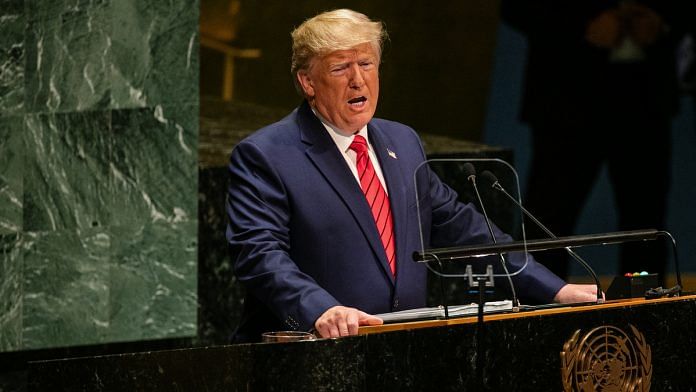New Delhi: India is ready to roll out red carpet for US President Donald Trump on 24 February, but the announcement of a much-touted limited trade deal between both the countries has come under question with New Delhi refusing to budge on trade benefits under Washington’s Generalised System of Preferences (GSP) scheme, ThePrint has learnt.
Less than a fortnight before the US President’s arrival, the Trump administration took a step that Indian trade negotiators dreaded the most, official sources said.
Countries with a share of 0.5 per cent or more of world trade will now be recognised as ‘developed’ countries, the notice said.
It also stated that countries that have G20 membership, of which India is a party, will not be seen any more as a ‘developing’ country.
In other words, technically, India will not be eligible anymore for the GSP trade benefits.
Under this scheme, the US granted some Indian exports, such as textiles and engineering goods, preferential or duty-free access to the American markets.
According to official sources, the move has “upset” India before the announcement of a limited trade deal, which was being planned to iron out some of the long-pending trade irritants.
Meanwhile, a much-awaited visit by USTR Robert Lighthizer and his meeting with Commerce and Industry Minister Piyush Goyal to prep-up the deal looked slim even as both sides continue to struggle to find a ground on the so-called trade package.
“A trade deal has never been a sure thing but there’s no better moment than the President’s trip to Delhi. Failure to get agreement by then won’t necessarily lead to suspension of negotiations but momentum will be lost,” said Mark Linscott, senior fellow at Atlantic Council (South Asia Center) and former assistant USTR for South and Central Asian Affairs.
India was mainly looking forward to the restoration of GSP, a preferential trade programme meant to boost the economies of developing nations, under the proposed limited deal.
The GSP benefits were withdrawn by the Trump administration in June last year after Prime Minister Narendra Modi came to power for the second time.
India had been seeking full or partial restoration of the GSP benefits, which led the country to export goods worth around $6 billion to America.
“We have two leaders that look at trade as a zero-sum game. So the space for compromise is fairly limited… Both India and the US continue to face rising trade deficits, so the pressure to slow imports is unrelenting in both nations,” said Richard M. Rossow, Wadhwani Chair in US India Policy Studies at The Center for Strategic and International Studies.
Also read: India-US trade deal will be latest win for Robert Lighthizer, Trump’s go-to negotiator
‘US eyeing India’s rice, wheat subsidies’
The limited trade deal between the US and India is also stuck on the fact that the US is now eyeing the subsidies that India offers to its farmers under the Minimum Support Programme for growing rice and wheat, said an official involved in the trade negotiations.
The US demand of tariff-free access for a range of its produce such as almonds, walnuts, apples, grapes, pomegranates and some dairy items, also remains.
“Given the state of Indian agriculture today and the government’s promise of doubling farmers income by 2020, India can ill-afford to open up the market to foreigners. I do not think India can do much right now to satisfy the American interests,” said Biswajit Dhar, trade economist and professor at the Jawaharlal Nehru University.
The US has also complained of non-tariff barriers limiting their agricultural exports.
“A trade deal will be extremely beneficial for the economic progress of both nations,” according to Mukesh Aghi, president and CEO, US India Strategic and Partnership Forum.
It is also to be noted that the US and India have not even been holding their annual trade dialogue — Trade Policy Forum — for the last couple of years as trade irritants continue to pile up. The dialogue started in 2005.
US upset over rising ‘trade protectionism’ in India
The Trump administration, similar to previous US administrations, is upset with the rise in trade protectionism in India.
Calling India a tariff-king, the Trump government has complained about India raising the tariffs in every successive finance budget since 2014, especially on IT products.
Sources, meanwhile, said that during Trump’s visit this month, both sides might announce a new dialogue on digital trade issues.
There are also very high chances that the beginning of negotiations on the Free Trade Agreement (FTA) will be announced.
“Both sides, but particularly India, continue to move ahead with trade protections. A real solution is not possible until we both have governments less focused on trade protections,” said Rossow.
Also read: ‘Welcome to India, President Trump’ — MEA plans multilingual greeting for POTUS







Extraordinarily small hearted to deny India GSP benefits. Some parts of the Indian economy are unquestionably on par with developed nations. However, there is a wide swathe of poverty. The labour intensive exports that benefited from GSP status cater to that segment of the population. Vietnam is firming up an FTA with the EU, something we have been struggling to accomplish for a long time. Unclear what kind of a trade deal we can stitch together with America when we cannot handle competition from Cambodia and Laos.